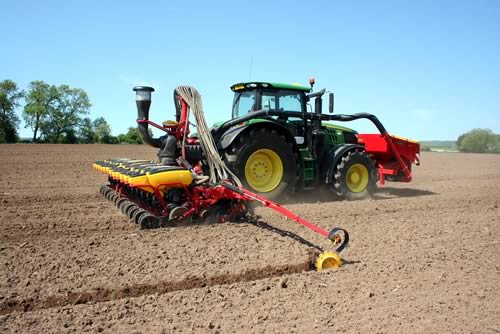2018-05-24 |
KWS Launches Maize Row Width Trial
The standard row width for sowing maize seed is 75cms, but plant breeder, KWS, has launched a new trial for this year, to study the effects of using a figure of 50cms.
The very high-yielding energy variety, Amaroc, has been sown at 50cms and 75cms row width in the trial plots, using rates of 110,000, 90,000 and 85,000 seeds/hectare. The late hybrid was drilled 16th May at the farm adjacent to the KWS headquarters in Lydney, Gloucestershire.
KWS row width trials
John Burgess of KWS says:
“The vast majority of UK maize is sown at
75cms row spacings, but this layout can cause a problem when applying
herbicide, because it is not possible to adopt a tramline system of
spraying. To counter this issue, many growers will travel diagonally
across the field and accept a degree of plant damage as a result,
while a 50cms row spacing would accommodate tramlines.
“Some farmers perceive that narrow row spacings would mean using higher seed rates to meet yield targets, but in fact seed rate and row width operate independently of each other. That is why we are also varying the seed rate, to monitor the effect on yield at harvest. The 110,000 seeds/hectare rate would apply to an early crop, drilled in mid-April, with a figure of 90,000 suitable for mid-season drilling. The 85,000 seeds/hectare rate would normally be applied where drilling takes place at the end of May to the first week in June.
“The spatial arrangement of seed at 50cms row width is expected to look markedly different from a crop sown at 75cms. Fewer plants per square metre will give individual plants the ability to intercept more sunlight and I would expect plants at the narrow row width to compensate for the extra space they have been given, by closing up the rows. Therefore, there should be no significant difference in yield, although the 50cms row spacing may produce taller plants.”
Seed for the trial will be sown using a Vaderstad Tempo drill, he adds.
“The Vaderstad Tempo is considered to be the most accurate machine of its type on the market; seed rates can be adjusted by the operator at the touch of a button, using an iPad.
“Amaroc is a variety which performs exceptionally well on farm. It has rapid early vigour and is ideal for spreading the drilling or harvest window.
“As plant breeders, we need to continually look at new and better methods of growing maize, in order to simplify management and improve farm profitability. Late hybrids do not generally tolerate narrow row spacings, so it will be interesting to review the trial results at the end of the year, and see whether an adjustment to row width has the potential to benefit our customers.”
As the drilling season approaches, Mr Burgess urges growers to take advantage of the KWS free, online soil temperature service, which provides local information at 10cms below the soil, based on the farm postcode. Ground temperature is also highlighted, to indicate the risk of frost. The below-ground temperature should reach 8°C and rising for 3-4 consecutive days before drilling and 12°C on heavier soils.
Andrew Gamble of Vaderstad reports that the Tempo planter has taken high speed drilling to the next level, maintaining even spacing and depth, which ensures the same conditions for each plant.
“The Tempo has the capacity to be used for planting a wide range of crops such as maize, sugar beet, oilseed rape, soya beans and sunflowers, with row spacings and other settings easily changeable,” says Mr Gamble.”It offers a high level of versatility, combined with increased efficiency and minimal machine costs per hectare.”


